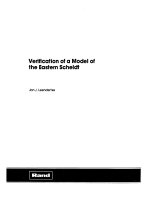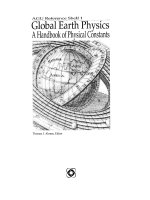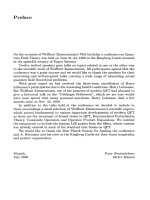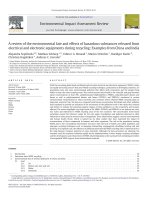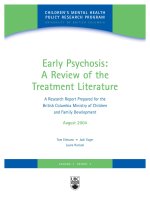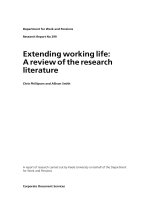- Trang chủ >>
- Khoa Học Tự Nhiên >>
- Vật lý
Coherent quantum physics; a reinterpretation of the tradition
Bạn đang xem bản rút gọn của tài liệu. Xem và tải ngay bản đầy đủ của tài liệu tại đây (4.73 MB, 298 trang )
Arnold Neumaier
Coherent Quantum Physics
www.pdfgrip.com
Texts and Monographs in
Theoretical Physics
|
Edited by
Michael Efroimsky, Bethesda, Maryland, USA
Leonard Gamberg, Reading, Pennsylvania, USA
www.pdfgrip.com
www.pdfgrip.com
Arnold Neumaier
Coherent Quantum
Physics
|
A Reinterpretation of the Tradition
www.pdfgrip.com
Mathematics Subject Classification 2010
Primary: 81P15, 81R30, 46E22; Secondary: 17B81, 81T99
Author
Prof. Dr. Arnold Neumaier
Universität Wien
Fakultåt für Mathematik
Oskar-Morgenstern-Platz 1
1090 Wien
Austria
ISBN 978-3-11-066729-5
e-ISBN (PDF) 978-3-11-066738-7
e-ISBN (EPUB) 978-3-11-066736-3
ISSN 2627-3934
Library of Congress Control Number: 2019947573
Bibliographic information published by the Deutsche Nationalbibliothek
The Deutsche Nationalbibliothek lists this publication in the Deutsche Nationalbibliografie;
detailed bibliographic data are available on the Internet at .
© 2019 Walter de Gruyter GmbH, Berlin/Boston
Cover image: Guy N Harris / iStock / Getty Images Plus
Typesetting: VTeX UAB, Lithuania
Printing and binding: CPI books GmbH, Leck
www.degruyter.com
www.pdfgrip.com
|
To Maria,
in honor of the Creator of our magnificent universe
www.pdfgrip.com
Download Date | 10/31/19 1:08 PM
www.pdfgrip.com
Preface
In a statistical description of nature only expectation values or correlations are observable.
Christof Wetterich, 1997 [299, p. 2678]
One is almost tempted to assert that the usual interpretation in terms of sharp eigenvalues is
‘wrong’, because it cannot be consistently maintained, while the interpretation in terms of expectation values is ‘right’, because it can be consistently maintained.
John Klauder, 1997 [160, p. 6]
What has become known as the quantum measurement problem […] encapsulates many of the fundamental conceptual difficulties that have to this date prevented us from arriving at a commonly
agreed-upon understanding of the physical meaning of the formalism of quantum mechanics and
of how this formalism relates to the perceived world around us.
Maximilian Schlosshauer, 2007 [265, p. VIII]
This book introduces mathematicians, physicists, and philosophers to a new, coherent approach to theory and interpretation of quantum physics (including quantum
mechanics, quantum statistical mechanics, quantum field theory, and their applications), in which classical and quantum thinking live peacefully side by side and jointly
fertilize the intuition.
An interpretation of quantum mechanics relates its formalism to the actual informal practice of using quantum mechanics in our scientific culture. An impeccable
interpretation must show that there is a fully consistent relation between theory and
practice. The interpretation may use concepts familiar from our culture to explain the
working of quantum physics in practice to everyone’s satisfaction.
What are the shortcomings of the current approaches? The minimal statistical
interpretation predicts the statistics of outcomes of experiments. It is silent about the
interpretation of quantum mechanics in the absence of measurements, and therefore
about the interpretation of quantum physics applied to the far past of the universe, before experiments were possible. This constitutes a serious gap—the interpretation is
consistent, but incomplete (as it should be for a “minimal” interpretation). The Copenhagen interpretation, which claims that nothing can be asserted in the absence of a
measurement, is also consistent. But this sounds like the concept that a tree fallen
in the wood has fallen only after someone has seen it. This is one of the reasons why
quantum mechanics comes across as somewhat strange. In a many-world interpretation, the world splits and splits, completely unnoticed by us, into all possible futures.
This is science fiction by conception. The other known interpretations are either variations of the above or require additional, in principle, unobservable, and hence fictional stuff. As a result, much of quantum physics appears to the general public as a
kind of quantum magic.
Why do physicists live with this? A noteworthy aspect of the standard interpretations is that the state vector cannot represent the whole universe, since it must
/>
www.pdfgrip.com
VIII | Preface
exclude an observer or measuring device that determines when a measurement has
occurred. This is the so-called Heisenberg cut between the quantum and the classical
world. To date, this has not been a problem in making successful experimental predictions, so practitioners are often satisfied with the quantum formalism in a standard interpretation. Tradition builds the quantum edifice on a time-honored foundation that
accounts for essentially all experimental facts. But it takes a “shut-up-and-calculate”
attitude towards the interpretation of the foundations. The traditional presentation of
quantum physics is clearly adequate for prediction, but seems not to be suitable for
an adequate understanding.
A second reason is that a number of popular “quantum magicians”, very experienced quantum physics practitioners specializing in quantum optics, like to give their
audience the impression that important parts of quantum mechanics are weird. And
the general public loves it! Part of the magicians’ art consists of remaining silent about
the true reasons why things work rationally, since then the weirdness is gone, and with
it the entertainment value.
Does quantum mechanics have to be weird? It sells much better to the general
public if it is presented that way, and there is a long history of proceeding like this. But
it is an obstacle for everyone who wants to truly understand quantum mechanics, and
to physics students, who have to unlearn what they were told as laypersons. When
presented in the right way, quantum mechanics is not at all weird, but very close to
classical mechanics. Much of the weirdness comes from forcing quantum mechanics
into the straightjacket of a particle picture. The particle picture breaks down completely in the subatomic domain, as witnessed by the many weird things that result
from such a view.
Coherent quantum physics removes the radical split between classical mechanics
and quantum mechanics. This book demonstrates that at any level of detail, Nature
can be rationally and objectively understood just by interpreting the traditional, wellestablished mathematics of quantum physics in an appropriate way. This requires a
reinterpretation of the tradition. The interpretation featured in this book succeeds
without any change in the theory, and without introducing new counterintuitive features or new theoretical concepts. The resulting quantum features then are only those
familiar from everyday life.
Nature, as we perceive it with our eyes, consists of images—in mathematical terms
2-dimensional fields, with properties (colors) at each point. Our brains interpret images as scenes in a, strictly speaking, not directly perceived 3-dimensional world of
objects. The same object seems larger or smaller depending on its distance from us,
with a shape that is deduced from images showing the object from different perspectives. All our observations are indirect: We perceive images and other sensory information and infer the true (theoretical, reproducible, invariant) properties of the objects
around us.
From the experience of the multitude of such sensory perceptions of many people,
our culture created a network of concepts and relations now called science, and in
www.pdfgrip.com
Preface
| IX
particular physics. Space has become 3-dimensional, represented at each particular
time by 3-dimensional fields that tell the spatial properties of the materials present
at each point in space. Their boundaries delineate the objects, some sharply, others—
such as clouds—only in a fuzzy way.
Space thus becomes equipped with many properties. There are local properties,
such as temperature, colors, hardness, stress, and chemical composition. In fluids
there are properties like salt concentration, but also pressure, streaming velocity, et
cetera. Each of these gives rise to a field that specifies how these properties vary with
the position in space. In addition, there are less tangible invisible properties, such as
those described by the electromagnetic field. The latter describes the properties responsible for the electric and magnetic phenomena in Nature, on which much of our
modern culture depends. Additionally, there are bilocal properties, such as distances
between two points in space. There are also nonlocal, region-dependent properties,
such as the diameter, mass, and volume of an extended object, or the surface area of
its boundary.
Objects often move. Just like photographs of stars in a long term night exposure,
they trace out tracks in an abstract 3-dimensional space. These tracks form curves
of a thickness depending on the objects’ size. The theory of special relativity teaches
us beyond this 3-dimensional picture of the world a 4-dimensional perspective in a
4-dimensional Minkowski space, whose coordinates represent both space and time.
Due to length contraction and time dilation, shapes look and clocks move differently
for observers moving at different velocities relative to each other. In special relativity,
moving points are represented by so-called world lines; the curves they trace out in
Minkowski space. The objects we see are extended in space, and therefore trace out
world tubes—thin or thick tracks in 4 dimensions with boundaries reflecting the sharp
or fuzzy, constant or changing shape of the objects.
Materials vibrate and produce sound. The electromagnetic field vibrates and produces light. Both are phenomena characterizing the behavior of waves. These can be
decomposed into harmonic waves of specified direction and frequency. The possible
frequencies of vibration make up a spectrum. A small part of these spectra are directly
observable by the human ear and eye; a very large part is indirectly observable through
various spectroscopic techniques.
Fields are representations of the continuum, infinitely divisible space and time.
But continuous fields are also the cause of discrete events. Continuous water waves
may cause discrete, random damage. Bullets fired on plexiglass described by the stress
fields of continuum mechanics cause visible, discrete random cracks emanating from
the center of impact. Casting a die, modeled by the continuous laws of classical mechanics, results in a random, discrete value—depending on which face it falls.
If we compare the motion of the Moon, a car, a leaf falling from a tree, or a pollen
corn in water, we realize that light objects move less predictably. This introduces a second form of randomness into scientific descriptions. Often, measurements do not produce exactly the same results. Typically, the best empirical approximation to the true
www.pdfgrip.com
X | Preface
value of something measured is a simple average of multiple measurements—there is
a democracy of measurement results. This insight, a form of the law of large numbers,
justifies statistical techniques. They allow one to obtain much useful information from
many inaccurate measurements.
This feature of Nature extends down to the smallest scales. On the scale of human experience, unanimated matter is highly predictable. But on the molecular and
atomic level, matter is observed to behave mostly in a random way. Therefore, the reproducible information about microscopic events consists mostly of statistical properties, such as chemical reaction rates. On the subatomic level, Nature’s behavior is
so uncertain that even the opinions on what exists are somewhat controversial.
A new approach. From a more technical perspective, the new approach described
in this book may be summarized as follows:
Coherent quantum physics is physics in terms of a coherent space consisting
of a line bundle over a classical phase space and an appropriate coherent product.
The kinematical structure of quantum physics and the meaning of the fundamental quantum observables are given by the symmetries of this coherent space, their
infinitesimal generators, and associated operators on the quantum space of the coherent space.
The formal, mathematical core of quantum physics is cleanly separated from the
interpretational issues. To achieve this, we need to avoid some of the traditional quantum mechanical jargon. In particular, following the convention of Allahverdyan
et al. [7], we add the prefix “q-” to all traditional quantum notions that suggest by
their name a particular interpretation, and hence might confuse the borderline between theory and interpretation. In particular, the operators usually called1 “observables” will be called “q-observables” to distinguish them from observables in
the operational sense of numbers obtainable from observation. Similarly, we use the
terms q-expectation and q-probability for the conventional but formally defined terms
expectation and probability.
Objective properties, including their uncertainties are given by q-expectations of
products of quantum fields and what is computable from these. The dynamics of the
universe is given by the Ehrenfest equations for q-expectations, and defines the dynamics of every physical subsystem by restriction. Particles are approximate effective
descriptions of certain extended blops of mass and/or energy, descriptions that make
sense only under special conditions.
Certain q-expectations are approximately observed in experiments. Like ordinary
averages, q-expectations become more accurate (that is, less uncertain) by averaging over many similar items. Averaging over macroscopic spacetime regions produces
macroscopic quantities with negligible uncertainty, and leads to classical physics.
1 This notion appears first in Dirac’s 1930 book [70, pp. 28]. Later editions make the restriction that
observables are Hermitian, and have real spectrum.
www.pdfgrip.com
Preface
| XI
The new approach involves one radical step, the reinterpretation of an assumption
underlying traditional quantum physics that was virtually never questioned before:
The eigenvalue link between theory and observation is replaced by a q-expectation
link. This leads to a new interpretation of quantum mechanics, the thermal interpretation, introduced in Chapter 9. It transforms the way one has to think about the
relation between theory and reality:
When performing on a quantum system a measurement of a quantity A with a
physical meaning, one gets an approximation for its value. The thermal interpretation
treats the measured value as an approximation not of an eigenvalue of A but of the qexpectation of A, the formal expectation value defined as the trace of the product of
A with a density operator describing the state of the system. The approximation error
is of the order of the uncertainty σA . This postulate is more or less implied by—and
hence more cautious than—the traditional postulate that the measured value is an
eigenvalue, obtained with the probability given by Born’s rule.
This novel postulate of the thermal interpretation remains therefore valid
in all cases where the traditional postulates apply. It avoids a number of problems
of Born’s rule (collected in the Appendix).
For this book, I rearranged, condensed, and augmented the material from a number of preprints (Neumaier [202, 203, 204, 205, 206, 207, 211] and Neumaier & Ghaani
Farashahi [212]; see also the exposition at the website Neumaier [200]) such that,
after an introductory chapter—explaining the reasons for the book and the main
results—the formal “shut-up-and-calculate”, probably less controversial part—comes
first, the thermal interpretation comes second, and the detailed critique of the tradition (that motivated everything) comes last.
The coherent foundations proposed here in a programmatic way resolve the problems with the traditional presentation of quantum mechanics discussed in the introductory Chapter 1. Part I features the mathematics of quantum physics, a formal core
and its development that follows in a purely logical way from basic axioms and definitions that build on it. It gives a coherent, interpretation-independent description
of quantum theory. Part II motivates, defines, and develops the thermal interpretation and its implication for the complex of conceptual issues called the measurement
problem. Part III is an Appendix containing a detailed critique of Born’s rule, a centerpiece of the tradition, of the concepts of states and ensembles, and a comparison
to traditional interpretations.
This book is not an introduction to quantum mechanics. Much of the material is intended to be nontechnical, needing only a fairly elementary background. It is aimed at
a wide audience that is familiar with some traditional quantum mechanics and basic
terms from functional analysis. But another large part of the material is addressed to
www.pdfgrip.com
XII | Preface
experts.2 There I refer to technical aspects, usually explained in the references given.
Thus, where necessary, I draw whatever seems relevant for coherent foundations from
functional analysis, quantum mechanics, quantum field theory, and statistical mechanics, while skipping many techniques that are treated in typical textbooks. For the
sake of definiteness, the fundamental description of Nature is taken in this book to be
given by 4-dimensional relativistic quantum field theory in Minkowski space-time.3
Since this is ongoing research, I also refer to material that is still unpublished and will
appear elsewhere.
For the discussion of questions related to this book, please use the discussion forum Physics Overflow at . See also my webpage
on the thermal interpretation at />therm. A list of errata will be maintained there; please report corrections to me at
I would like to thank Arash Ghaani Farashahi, Waltraud Huyer, Rahel Knöpfel,
David Bar Moshe, Mike Mowbray, Karl-Hermann Neeb, Hermann Schichl and Eric Wofsey for useful discussions related to coherent spaces. The material on interpretation
benefited from discussions with Hendrik van Hees, Rahel Knöpfel, Mike Mowbray,
Paul Pöll, and Francois Ziegler, which are also gratefully appreciated.
The puzzle of making sense of the foundations of quantum physics held my attention for many years. Around 2003, I discovered that group coherent states are for many
purposes very useful objects; before, they were—for me—just a facet that physicists
(who needed them for quantum optics) studied. In 2007, I realized that apparently
all of quantum mechanics and quantum field theory can be profitably cast into this
form, and that coherent states may provide better theoretical foundations for quantum mechanics and quantum field theory than the current Fock space approach. Since
then I have been putting them bit by bit into the new framework, and always found
(after some work) everything nicely fitting. With each new piece in place, I got insights about how to interpret everything, and things got simpler and simpler as I proceeded. Or rather, more and more complicated things became understandable without significantly increasing the complexity of the new picture. Everything became
much more transparent and intuitive than the traditional mental picture of quantum
physics.
Hints at a possible thermal interpretation of quantum physics go back at least to
1997; see the above quotes by Wetterich and Klauder. The thermal interpretation of
quantum physics itself emerged from my foundational 2003 paper Neumaier [194].
2 Nonexperts are advised to simply skip the more advanced passages and continue reading when the
discussion becomes again less technical. In particular, Part II does not depend on Chapters 4–6 and
Section 7.2, and Part III is independent of Parts I and II.
3 It does not matter whether or not there is a deeper underlying structure, such as that of string theory,
in terms of which quantum field theory would be an effective theory only. For simplicity, curved spacetimes are not considered.
www.pdfgrip.com
Preface
| XIII
It was developed by me in discussions on the newsgroups de.sci.physik, starting in
Spring 2004, and in later discussions on PhysicsForums; for the beginnings see Neumaier [196]. A first version of it was fully formalized (without naming the interpretation) in Sections 5.1, 5.4, and Chapter 7 of the 2008 edition of the online book by Neumaier & Westra [214]; see also Sections 8.1, 8.4, and Chapter 10 of the 2011 edition.
The term “thermal interpretation” appeared first in a 2010 lecture (Neumaier [197]).
Later I created a dedicated website on the topic (Neumaier [198]). A recent view closely
related to the thermal interpretation is the 2017 work by Allahverdyan et al. [7].
I trust you will enjoy reading the book!
Vienna, June 14, 2019,
Arnold Neumaier
www.pdfgrip.com
www.pdfgrip.com
Foreword
The predictions of quantum mechanics are remarkably accurate, but aspects of the
interpretation of quantum mechanics are still not agreed upon.
The use of coherent states as basic tools in quantum mechanics has several advantages. As an example, I cite their role in quantum/classical issues, as illustrated
by the quantum action functional given by
𝜕
AQ = ∫ ⟨ψ(t)(iℏ − H(P, Q))ψ(t)⟩dt
𝜕t
for normalized general Hilbert space vectors |ψ(t)⟩. However, classical observers may
be limited to fewer vectors, such as
−iq(t)P/ℏ ip(t)Q/ℏ
e
|any⟩,
p(t), q(t)⟩ = e
which involve moving the system to a new position q or new velocity v = p/m. This
leads to
𝜕
AC = ∫ ⟨p(t), q(t)(iℏ − H(P, Q))p(t), q(t)⟩dt
𝜕t
̇ − H(p(t), q(t)))dt + O(ℏ; p(t), q(t)).
= ∫ (p(t)q(t)
Observe that this is the classical action functional, with quantum corrections for ℏ > 0,
as it must be in the real world.
The author’s book is full of connections of this sort, and they can certainly help
in clarifying quantum mechanics!
August 7, 2019
John R. Klauder
/>
www.pdfgrip.com
www.pdfgrip.com
Contents
Preface | VII
Foreword | XV
1
1.1
1.2
1.3
1.4
1.5
1.6
1.7
Introduction | 1
The 7 basic rules of quantum mechanics | 1
Interpretations of quantum mechanics | 3
Quantum magic | 5
Coherent quantum physics | 8
Overview to Part I | 10
Overview to Part II | 11
Overview to Part III | 12
Part I: Mathematical concepts for quantum physics
2
2.1
2.2
2.3
2.4
2.5
2.6
Basic quantum physics | 17
Axioms for the formal core of quantum physics | 17
The Ehrenfest picture of quantum mechanics | 19
The classical approximation | 23
The Rydberg–Ritz combination principle | 25
The pure state idealization | 27
Schrödinger equation and formal Born rule | 28
3
3.1
3.2
3.3
3.4
3.5
3.6
3.7
Uncertainty, statistics, probability | 31
Uncertainty | 31
Expectations as properties of anonymous events | 34
Classical probability via expectation | 35
Description dependence of probabilities | 39
The stochastic description of a deterministic system | 41
Deterministic and stochastic aspects of q-expectations | 42
What is probability? | 45
4
4.1
4.2
4.3
Euclidean spaces | 47
Euclidean spaces and their antidual | 47
Norm and completion of a Euclidean space | 50
Linear mappings between Euclidean spaces | 53
www.pdfgrip.com
XVIII | Contents
4.4
4.5
4.6
4.7
4.8
4.9
4.10
Functions of positive type | 54
Constructing functions of positive type | 56
The Moore–Aronszajn theorem | 59
Reproducing kernel Hilbert spaces and Mercer’s theorem | 61
Theorems by Bochner and Kreĭn | 62
Theorems by Schoenberg and Menger | 64
The Berezin–Wallach set | 66
5
5.1
5.2
5.3
5.4
5.5
5.6
5.7
5.8
5.9
5.10
Coherent spaces | 69
Motivation for coherent spaces | 69
Coherent spaces | 70
Quantum spaces | 72
Length, angle, distance | 75
Vectors in the augmented quantum space | 77
New states from old ones | 78
Some examples | 79
Normal, projective, and nondegenerate coherent spaces | 83
Symmetries | 88
Uses of coherent spaces | 90
6
6.1
6.2
6.3
6.4
6.5
6.6
6.7
6.8
6.9
Coherent quantum physics | 93
The coherent action principle | 93
Systems with classical and quantum view | 94
Quantization and the dynamics of q-observables | 97
Relations to geometric quantization | 100
Lie ∗-algebras | 102
Quantities, states, uncertainty | 103
Examples | 106
Coherent chaos | 107
Dynamical Lie algebras | 109
7
7.1
7.2
7.3
7.4
7.5
7.6
7.7
7.8
7.9
7.10
Quantum field theory and quantum statistical mechanics | 113
Fields and their dynamics | 114
Coherent spaces for quantum field theory | 116
Observability in quantum field theory | 119
Currents | 121
Coarse-graining | 123
Gibbs states | 124
Nonequilibrium statistical mechanics | 126
Conservative mixed quantum-classical dynamics | 129
Important examples of quantum-classical dynamics | 131
Koopman’s representation of classical statistical mechanics | 132
www.pdfgrip.com
Contents | XIX
Part II: The interpretation of quantum physics
8
8.1
8.2
8.3
8.4
8.5
8.6
Requirements for good foundations | 135
Interpreting the formal core | 135
The interpretation of mature theories | 137
Is quantum physics a mature theory? | 141
Objective properties | 144
The universe as a quantum system | 146
A classical view of the qubit | 147
9
9.1
9.2
9.3
9.4
9.5
The thermal interpretation of quantum physics | 151
A reinterpretation of the tradition | 151
The thermal interpretation | 153
The interpretation of quantum-classical systems | 160
Advantages of the thermal interpretation | 161
Open problems | 163
10
10.1
10.2
10.3
10.4
10.5
10.6
10.7
Measurement | 165
Objective properties and their measurement | 165
Physical systems and their states | 167
A single qubit as a subsystem of the universe | 168
The emergence of Born’s rule | 170
Relations to decoherence | 174
Measurement errors | 175
What should be the true value? | 178
11
11.1
11.2
11.3
11.4
11.5
11.6
11.7
11.8
Measurement devices | 181
Measurement protocols | 182
Statistical and deterministic measurements | 184
Macroscopic systems and deterministic instruments | 187
Statistical instruments | 189
Probability measurements | 190
Chaos, randomness, and quantum measurement | 193
The statistical mechanics of definite, discrete events | 195
Dissipation, bistability, and Born’s rule | 198
12
12.1
12.2
12.3
12.4
12.5
Particles | 201
The photoelectric effect | 202
Particle tracks | 204
How real are particles? | 206
Particles from quantum fields | 208
Fock space and particle description | 209
www.pdfgrip.com
XX | Contents
12.6
12.7
Physical particles in interacting field theories | 210
Semiclassical approximation and geometric optics | 211
13
13.1
13.2
13.3
13.4
13.5
13.6
Some quantum experiments | 215
Quantum buckets and time-resolved events on a screen | 215
Particle decay | 216
The Stern–Gerlach experiment in terms of currents | 218
The Stern–Gerlach experiment in terms of particles | 220
Relativistic causality | 222
Nonlocal correlations and conditional information | 223
Part III: Appendix: Critique of the tradition
14
14.1
14.2
14.3
A critique of Born’s rule | 229
Early, measurement-free formulations of Born’s rule | 230
Formulations of Born’s rule in terms of measurement | 232
Limitations of Born’s rule | 235
15
15.1
15.2
15.3
15.4
Pure states and mixed states | 239
What is a state? | 239
The nature of mixed state? | 241
What is an ensemble? | 243
Pure states in quantum field theory | 244
16
16.1
16.2
16.3
Traditional interpretations | 247
A classification of interpretations | 248
The Copenhagen interpretation | 249
The minimal statistical interpretation | 253
Bibliography | 257
Authors | 271
Index | 275
www.pdfgrip.com
1 Introduction
This chapter sets the informal stage for the subject matter of the book. Section 1.1
presents in concise form what is typically taught as the basics in quantum physics
courses around the world. Section 1.2 gives a short overview of the most important interpretations of these basic rules that were spawned by a century-long lack of clarity
of the meaning of quantum mechanics. Section 1.3 gives an account of the deplorable
tradition of quantum magic that resulted from this lack of clarity. Section 1.4, the final
section, gives a preview of the coherent quantum physics proposed in this book as a
solution to the problems of interpreting quantum physics.
1.1 The 7 basic rules of quantum mechanics
The 7 basic rules (BR1)–(BR7) given below (taken from Neumaier [211]) reflect what is
typically taught as the basics in quantum physics courses around the world. They are
found in almost all introductory quantum mechanics textbooks.1 Often they are stated
in terms of axioms or postulates, but this is not essential for their practical validity. In
some interpretations, some of these rules are not considered fundamental rules, but
as empirical or effective rules for practical purposes.
The footnotes contain generalizations of these rules for degenerate eigenvalues,
for mixed states, and for measurements not defined by self-adjoint operators, but by
POVMs: see Footnote 7 below. These generalizations are necessary to apply quantum
mechanics to all situations encountered in practice. The basic rules are carefully formulated so that they are correct as they stand and, at the same time, fully compatible
with these generalizations.
(BR1) A quantum system is described using a Hilbert space2 ℋ.
(BR2) A pure state of a quantum system is represented by a normalized vector
|ψ⟩ in ℋ; state vectors differing only by a phase factor of absolute value 1 represent
the same state.3 In the position representation, where the Hilbert space is the space
of square integrable functions of a position vector x, ψ(x) is called the wave function
of the system.
1 Among them are: Basdevant 2016; Cohen-Tannoudji, Diu and Laloe 1977; Dirac 1930, 1967; Gasiorowicz 2003; Greiner 2008; Griffiths and Schroeter 2018; Landau and Lifshitz 1958, 1977; Liboff 2003; McIntyre 2012; Messiah 1961; Peebles 1992; Rae and Napolitano 2015; Sakurai 2010; Shankar 2016; Weinberg
2013. Even Ballentine 1998, who rejects rule (BR7), whose process (9.9), as fundamental, derives it in
the form of his (9.21) as an effective rule.
2 Often, this Hilbert space is assumed to be separable, that is, to have a countable orthonormal basis.
3 Equivalently, a pure state can be represented by a rank 1 density operator ρ = |ψ⟩⟨ψ|, satisfying
ρ2 = ρ = ρ∗ and Tr ρ = 1. Mixed states are represented by more general (nondempotent) Hermitian
density operators of trace 1.
/>
www.pdfgrip.com
2 | 1 Introduction
(BR3) The time evolution of an isolated quantum system represented by the state
vector |ψ(t)⟩ is given by4
iℏ
d
ψ(t)⟩ = H ψ(t)⟩,
dt
where H is the Hamilton operator and ℏ is Planck’s constant. This is the Schrödinger
equation. This rule is valid in the formulation of quantum mechanics called the
Schrödinger picture. There are other, equivalent formulations of the time evolution,
especially the Heisenberg picture and the interaction pictures, where time evolution
is entirely or partially shifted from the state vector to the operators.
(BR4) An observable of a quantum system is represented by a Hermitian operator
A with real spectrum5 acting on a dense subspace of ℋ.
(BR5) The possible measured values of a measurement of an observable are the
spectral values of the corresponding operator A. In the case of a discrete spectrum,
these are the eigenvalues a satisfying A|a⟩ = a|a⟩.
(BR6) Let {|a⟩} be a complete set of (generalized) eigenvectors of the self-adjoint
operator A with spectral values a. Let the quantum system be prepared in a state represented by the state vector |ψ⟩. If a measurement of the observable corresponding
to A is performed, the probability (density) pψ (a) for finding the measured value a is
given by
2
pψ (a) = ⟨a|ψ⟩ .
This is Born’s rule, in a formulation that assumes that all eigenvalues are nondegenerate.6
(BR7) For successive, nondestructive projective measurements with discrete results,7 each measurement with measuring value a can be regarded as the preparation
4 It is equivalent to define the time evolution of an isolated quantum system by
ψ(t)⟩ = U(t)ψ(0)⟩
with the unitary time evolution operator U(t) = e−iHt/ℏ . The evolution according to (BR3) is therefore
also referred to as unitary evolution.
5 Equivalently, A is self-adjoint.
6 In the case of degenerate eigenvalues, let {|a, ν⟩} be a complete set of (generalized) eigenvectors
of A, indexed by ν. The probability pψ (a) for finding the measured value a is then given by summing
(or integrating) over ν, that is, over the entire a-subspace
2
pψ (a) = ∑⟨a, ν|ψ⟩ .
ν
7 The projection postulate is valid only under the assumptions stated, such as passing barriers with
holes or slits, polarization filters, and certain other instruments that modify the state of a quantum system passing through it. This (nonunitary, dissipative) change of the state to an eigenstate in the course
Brought to you by | Stockholm University Library
Authenticated
Download Date | 10/28/19 5:01 PM
www.pdfgrip.com
1.2 Interpretations of quantum mechanics | 3
of a new state, whose state vector is the corresponding eigenvector |a⟩, to be used for
the calculation of subsequent time evolution and further measurements. This is the
von Neumann projection postulate.
These rules say nothing about the practically very important problem of how
to handle a nonisolated quantum system outside of explicit measurement contexts.
Hence they are only an approximate guide to the meaning of quantum mechanics
in general. Applying the rules in practice requires further assumptions and developments.
1.2 Interpretations of quantum mechanics
My ‘orthodoxy’ is not identical to that of Bohr, nor to that of Peierls, to mention two especially eminent examples. Hence I must state my definition of ‘orthodoxy’.
Kurt Gottfried, 1991 [103, p. 36]
Orthodox QM, I am suggesting, consists of shifting between two different ways of understanding
the quantum state according to context: interpreting quantum mechanics realistically in contexts
where interference matters, and probabilistically in contexts where it does not. Obviously this is conceptually unsatisfactory (at least on any remotely realist construal of QM) – it is more a description
of a practice than it is a stable interpretation. […] The ad hoc, opportunistic approach that physics
takes to the interpretation of the quantum state, and the lack, in physical practice, of a clear and
unequivocal understanding of the state – this is the quantum measurement problem.
David Wallace, 2016 [292, p. 22, p. 24]
Not further discussing the foundations of quantum mechanics beyond this is called
shut-up-and-calculate. It is the mode of working sufficient for all who do not want
to delve into often highly disputed foundational (and partly philosophical) problems.
However, the above-mentioned rules are often considered conceptually unsatisfactory
because they introduce not well-defined terms “probability”, “measurement”, and
“observer” to define these basic rules, whereas in principle one expects that at least
measurement and observation can be regarded as quantum mechanical processes or
interactions, which follow the same fundamental rules and do not play any special
role. The associated issues are treated in different ways by different interpretations
of quantum mechanics.
In the Copenhagen interpretation (also called standard interpretation or orthodox interpretation; terminology and interpretation details vary), the above rules
of a projective measurement is often referred to as “state reduction” or “collapse of the wave function”
or “reduction of the wave packet”. Note that there is no direct conflict with the unitary evolution in
(BR3), since during a measurement a system is never isolated.
In other cases, the prepared state may be quite different; see the discussion in Landau & Lifschitz
[171, Section 7]. The most general kind of quantum measurement and the resulting prepared state is
described by so-called positive operator valued measures (POVMs).
Brought to you by | Stockholm University Library
Authenticated
Download Date | 10/28/19 5:01 PM
www.pdfgrip.com

